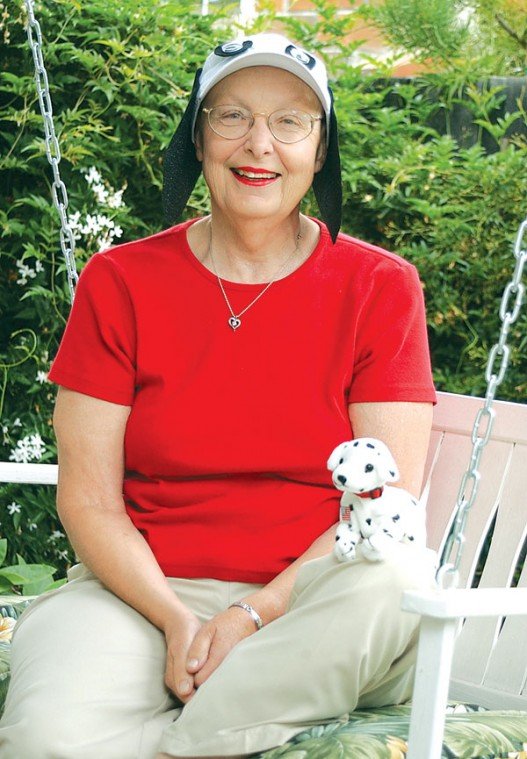GILROY
– For 42 years as a nurse, Ruth Slechta worked with people
fighting cancer, but she never thought she’d have to fight it
herself one day.
GILROY – For 42 years as a nurse, Ruth Slechta worked with people fighting cancer, but she never thought she’d have to fight it herself one day.
Just two years into retirement, the long-distance bike rider – in excellent physical condition – regularly met with her doctor without any signs of problems.
And then, out of nowhere, she was diagnosed with ovarian cancer in August.
“I know the symptoms,” said Slechta, who had seen many cases of cancer in her career, which included 13 years working in hospice care, five of them at Hospice of the Valley in San Jose. “It never crossed my mind. I don’t have any family history.
“I thought I had an ulcer,” she said. “The symptoms are very vague.”
Slechta was just like the 23,000 women who are diagnosed with ovarian cancer each year – completely in shock and caught totally off-guard. About 14,000 women will die from the disease this year.
“I was in the third stage,” she said. “There are four stages to ovarian cancer. Normally, it’s caught in an advanced stage.”
Slechta’s news didn’t get any better, as test results showed the cancer had metastasized in her pelvic area and lower intestines. Within five days, she was in major surgery and spent a week in the hospital. In less than a week, Slechta’s life had been turned upside-down, and she hadn’t even had time to think about it.
“Just shock … disbelief that it happened to you,” she said about her reaction to the news she had cancer. “I didn’t even have a chance to get out of that stage (before I was in surgery).”
Within a week of surgery, Slechta began the first of six chemotherapy treatments over five months.
“I began chemotherapy before I was even on my feet,” she said. “That’s how aggressive they are with this now.”
It took several weeks before Slechta was able to simply break down and cry and let out the emotions of fear, pain and uncertainty of the future. She knew the fight against the disease had just begun.
“I wrote my obituary in my second week,” she said. “You’re going to give it the best you have, but you realize that this is a difficult disease.”
Fortunately, Slechta’s support base was as strong as her will. Besides the love from her husband, children and grandchildren, members of the church where she sings in the choir, friends and former coworkers all came to her aid.
“You don’t go through the disease alone,” she said. “People who deal with this disease need listeners and support. I’ve had people send me a card every week since the day I was diagnosed.”
She said her children visited her every weekend and her husband, Al, was behind every step of the way.
“He just jumped right in,” she said. “He took over for a while until I started being able to cope on my own again.”
Eight weeks after completing the grueling chemotherapy treatments, Slechta returned to the hospital, and doctors performed a “look-through” surgery in order to search for signs of cancer returning. They didn’t find anything.
“I was one of the fortunate ones,” she said.
However, after the surgery, her incision refused to heal, and it took until the end of May before it finally healed. Amazingly, less than a year after she was diagnosed with cancer, Slechta’s life is getting back to normal.
“I just did 52 miles last week (on my bike),” Slechta said. “I’m working on the hills to get stronger.”
While Slechta’s life is back in order, she has been forever changed by her experience. She now spends much of her time working as an advocate for other women who have been diagnosed with cancer.
The women she is working with now are ages 37 to 49, all seemingly too young to be worrying about cancer. Unfortunately, unlike with men and prostate cancer, there is no routine test for women that can check for ovarian cancer. Usually, women over the age of 60 are high-risk, but women of any age can have it.
“I feel myself fortunate because I have had two children and I have grandchildren,” she said about the women she supports. “They’re in the prime of their lives.”
Slechta spends time with the women, meeting for lunch or talking on the phone for support.
“It really is a life-changing event,” she said.
Slechta also is a team captain for the American Cancer Society’s 2003 Relay For Life, which will take place at the ranch side Christmas Hill Park Saturday and Sunday.
The annual event is a 24-hour walk where teams, which have collected money from donors in the past few weeks, will continuously have a member walking around a track. At night the track will be lit with luminarias representing cancer survivors and those who have died from cancer.
Each team chooses a theme and creates a themed camp site to show their spirit. Slechta’s team chose a dalmatian theme.
“I have dalmatian hats for everyone to wear,” Slechta said. “They’re dumb-looking, but that’s all right.”
The event includes live music, games, movies and appearances of the San Francisco 49er gold rush cheerleaders and the Garlic Queen and her court. There will be a ceremonial survivors lap to open the event Saturday where all the local cancer survivors will walk the track and be cheered by the teams.
Over the course of the weekend, the ACS hopes to raise $115,000, up from $82,000 last year. In 2002, $15.2 million was raised in California and $245 million was raised nationwide. The money will be used for cancer research, prevention, patient services and detection and treatment of cancer.
“My goal was $1,000,” Slechta said. “We’ve probably raised $3,000.”
This year, 46 teams have registered to take part in the event, up from 28 last year.
“It’s a huge jump,” said Ingrid Dick, special events manager for the Silicon Valley/Central Coast region for the American Cancer Society. “We have the most fabulous volunteers this year.”
Slechta’s team – including herself – has six cancer survivors, and she said it was easy to get others to join in. However, they’re a little less happy about wearing the goofy-looking dog hats.
“They ask if they have to wear them,” she said. “They’re more concerned with people seeing them with the hat on.”














